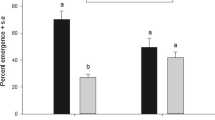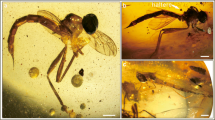Abstract
Species ofPachyneuron (Hym.: Pteromalidae) have been recorded as either primary parasites or hyperparasites.P. concolor (Foerster) is a polyphagous secondary parasite, attacking encyrtid primary parasites in soft scales, mealy bugs and coccinellid larvae. It also develops as a tertiary parasite.
We now report thatP. concolor may also develop as a primary parasite of aphidophagous fly puparia. Host selection in this species appears to be based on locating a soft-bodied host within a hard, dry shell, independent of whether the host is a dipterous pupa in its puparium or a primary parasite in its mummified host.
The overall effect ofP. concolor is detrimental. Its introduction into new areas should definitely be avoided.
Résumé
Des espèces dePachyneuron (Hym.: Pteromalidae) ont été signalées être des parasites primaires ou des hyperparasites.P. concolor (Foerster) est un parasite secondaire polyphage attaquant les encyrtides parasites primaires des cochenilles et des larves de coccinelles. Il peut également se développer en parasite tertiaire. On indique ici queP. concolor peut aussi vivre en parasite primaire de pupes de diptères aphidiphages. Le choix de l'hôte par cette espèce apparaît déterminé par la localisation d'un hôte au corps mou dans une enveloppe dure et sèche, indépendamment du fait que cet hôte soit une nymphe de diptère dans son puparium ou d'un parasite primaire dans son hôte momifié.
L'action globale deP. concolor est nuisible. L'introduction de ce parasite dans de nouvelles régions est en définitive à éviter.
Similar content being viewed by others
References
Bennett, F.D. — 1981. Hyperparasitism in the practice of biological control. In: The Role of Hyperparasitism in Biological Control: A Symposium (D. Rosen, ed.). —Div. Agric. Sci. Univ. Calif. Publ., 4103, 43–49.
Burks, B.D. — 1979. FamilyPteromalidae. pp. 768–835. In: Catalog of Hymenoptera in America North of Mexico (K.V. Krombein, P.D. Hurd, Jr., D.R. Smith &B.D. Burks, ed.) —Smithsonian Institution Press, Washington, D.C.
Clausen, C.P. — 1940. Entomophagous Insects. —McGraw-Hill, New York.
Ehler, L.E. — 1979. Utility of facultative secondary parasites in biological control. —Environ. Entomol., 8, 829–832.
Flanders, S.E. — 1959. Differential host relations of the sexes in the parasitic Hymenoptera. —Entomol. Exp. Appl., 2, 125–142.
— — 1963. Hyperparasitism, a mutualistic phenomenon. —Can. Entomol, 95, 716–720.
Gordh, G. — 1981. The phenomenon of insect hyperparasitism and its taxonomic occurrence in the Insecta. In: The Role of Hyperparasitism in Biological Control: A Symposium, (D. Rosen, ed.). —Div. Agric. Sci. Univ. Calif. Pub. 4103, 10–18.
Graham M.W.R. de V. — 1969. ThePteromalidae of north-western Europe [Hymenoptera: Chalcidoidea]. —Bull. Brit. Mus. (Nat. Hist.), Entomol., Suppl. 16, 908 pp.
Howard, L.O. — 1891. The habits ofPachyneuron. —Proc. Entomol. Soc. Wash., 11, 105–109.
Kfir, R. &Rosen D. — 1981. Biology of the hyperparasitePachyneuron concolor (Förster) [Hymenoptera: Pteromalidae] reared onMicroterys flavus (Howard) in brown soft scale. —J. Entomol. Soc. Sth. Afr., 44, 151–163.
Luck, R.F., Messenger, P.S. & Barbieri, J.F. — 1981. The influence of hyperparasitism on the performance of biological control agents. In: The Role of Hyperparasitism in Biological Control: A Symposium (D. Rosen, ed.). —Div. Agric. Sci. Univ. Calif. Publ., 4103, 34–42.
Muesebeck, C.F.W. & Dohanian, S.M. — 1927. A study in hyperparasitism, with particular reference to the parasites ofApanteles melanoscelus (Ratzeburg). —U.S. Dep. Agric. Bull., 1487, 36 pp.
Rosen D. — 1981. Some concluding remarks. In: The Role of Hyperparasitism in Biological Control: A Symposium (D. Rosen, ed.). —Div. Agric. Sci. Univ. Calif. Publ., 4103, 50–52.
Rosen, D. &Gerson, U. — 1965. Field studies ofChilocorus bipustulatus (L.) on citrus in Israel. —Ann. Epiphyt., 16, 71–76.
Smith, H.S. — 1916. An attempt to redefine the host relationships exhibited by entomophagous insects. —J. Econ. Entomol., 9, 477–486.
Timberlake, P.H. — 1926. New species of Hawaiian chalcid-flies [Hymenoptera]. —Proc. Hawaii. Entomol. Soc., 6, 305–320.
Viggiani, G., — 1981. Hyperparasitism and sex differentiation in theAphelinidae. In: The Role of Hyperparasitism in Biological Control: A Symposium (D. Rosen, ed.) —Div. Agric. Sci. Univ. Calif. Publ., 4103, 19–26.
Weseloh, R.M., Wallner W.E. &Hoy, M.A. — 1979. Possible deleterious effects of releasingAnastatus kashmirensis, a facultative hyperparasite of the gypsy moth. —Environ. Entomol., 8, 174–177.
Author information
Authors and Affiliations
Rights and permissions
About this article
Cite this article
Rosen, D., Kfir, R. A hyperparasite of coccids develops as a primary parasite of fly puparia. Entomophaga 28, 83–87 (1983). https://doi.org/10.1007/BF02372100
Issue Date:
DOI: https://doi.org/10.1007/BF02372100




